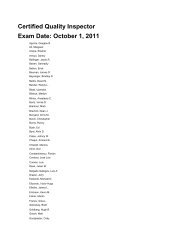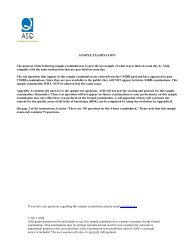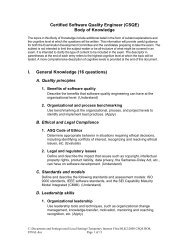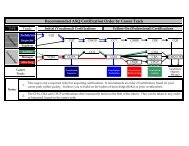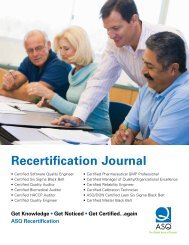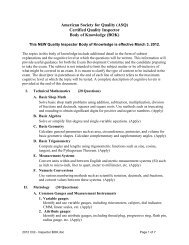Certified Software Quality Engineer (CSQE) Body of Knowledge - ASQ
Certified Software Quality Engineer (CSQE) Body of Knowledge - ASQ
Certified Software Quality Engineer (CSQE) Body of Knowledge - ASQ
Create successful ePaper yourself
Turn your PDF publications into a flip-book with our unique Google optimized e-Paper software.
2. Basic measurement theory and statistics<br />
Define the central limit theorem, and describe and use mean, median,<br />
mode, standard deviation, variance, and range. Apply appropriate<br />
measurement scales (nominal, ordinal, ratio, interval) in various situations.<br />
(Apply)<br />
3. Psychology <strong>of</strong> metrics<br />
Describe how metrics and measuring affect the people whose work is being<br />
measured and how people affect the ways in which metrics are used and<br />
data are gathered. (Understand)<br />
B. Process and product measurement<br />
1. <strong>S<strong>of</strong>tware</strong> metrics<br />
Use metrics to assess various s<strong>of</strong>tware attributes such as size, complexity,<br />
number <strong>of</strong> defects, the amount <strong>of</strong> test coverage needed, requirements<br />
volatility, and overall system performance. (Apply)<br />
2. Process metrics<br />
Measure the effectiveness and efficiency <strong>of</strong> s<strong>of</strong>tware using functional<br />
verification tests (FVT), cost, yield, customer impact, defect detection,<br />
defect containment, total defect containment effectiveness (TDCE), defect<br />
removal efficiency (DRE), process capability and efficiency, etc. (Apply)<br />
3. Metrics reporting tools<br />
Use various metric representation tools, including dashboards, stoplight<br />
charts, etc., to report results efficiently. (Apply)<br />
C. Analytical techniques<br />
1. Sampling<br />
Define and distinguish between sampling methods (e.g., random, stratified,<br />
cluster) as used in auditing, testing, product acceptance, etc. (Understand)<br />
2. Data collection and integrity<br />
Describe the importance <strong>of</strong> data integrity from planning through collection<br />
and analysis, and apply various techniques to ensure its quality, accuracy,<br />
completeness, and timeliness. (Apply)<br />
3. <strong>Quality</strong> analysis tools<br />
Describe and use classic quality tools (flowcharts, Pareto charts, cause and<br />
effect diagrams, control charts, histograms, etc.) and problem-solving tools<br />
(affinity and tree diagrams, matrix and activity network diagrams, root cause<br />
analysis, etc.) in a variety <strong>of</strong> situations. (Apply)<br />
C:\Documents and Settings\oneil\Local Settings\Temporary Internet Files\OLK2\2008 <strong>CSQE</strong> BOK<br />
FINAL.doc Page 7 <strong>of</strong> 11





